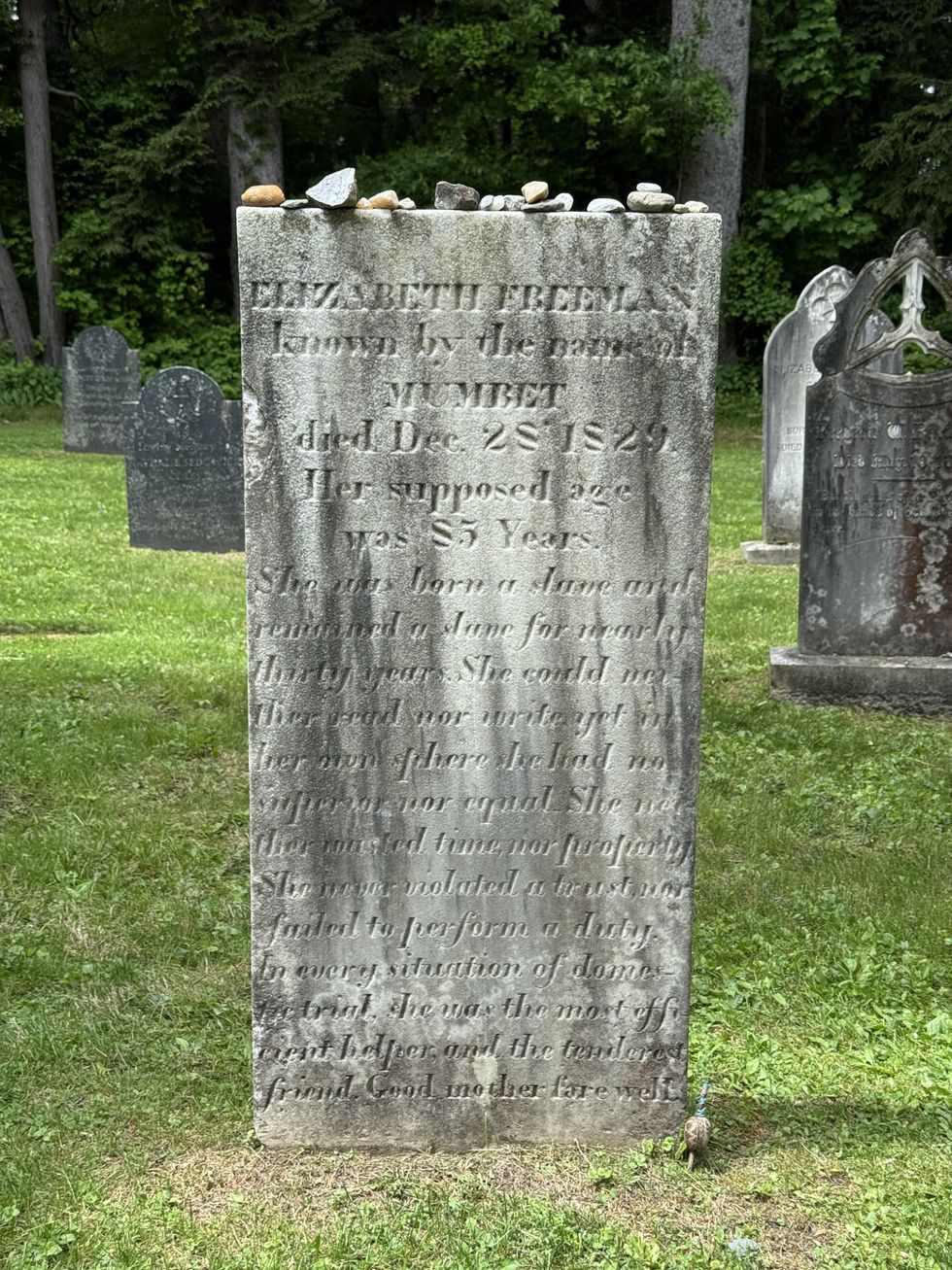Latest News
Juneteenth and Mumbet’s legacy
Jun 18, 2025
Sheffield resident, singer Wanda Houston will play Mumbet in "1781" on June 19 at 7 p.m. at The Center on Main, Falls Village.
Jeffery Serratt
In August of 1781, after spending thirty years as an enslaved woman in the household of Colonel John Ashley in Sheffield, Massachusetts, Elizabeth Freeman, also known as Mumbet, was the first enslaved person to sue for her freedom in court. At the time of her trial there were 5,000 enslaved people in the state. MumBet’s legal victory set a precedent for the abolition of slavery in Massachusetts in 1790, the first in the nation. She took the name Elizabeth Freeman.
Local playwrights Lonnie Carter and Linda Rossi will tell her story in a staged reading of “1781” to celebrate Juneteenth, ay 7 p.m. at The Center on Main in Falls Village, Connecticut.Singer Wanda Houston will play MumBet, joined by actors Chantell McCulloch, Tarik Shah, Kim Canning, Sherie Berk, Howard Platt, Gloria Parker and Ruby Cameron Miller. Musical composer Donald Sosin added, “MumBet is an American hero whose story deserves to be known much more widely.”
Houston has shared the stage with stars ranging from Barbra Streisand to Motown great Mary Wells. “I have had the honor of portraying Elizabeth Freeman for three years in “Meet Elizabeth Freeman” by Teresa Miller. Our first reading of “1781” is in celebration of Juneteenth, which is wonderfully symbolic and poignant.” Juneteenth celebrates the end of slavery. Two years after President Lincoln issued the Emancipation Proclamation in 1863, word of their freedom finally reached slaves in Texas on June 19, 1865.

MumBet, born in 1742 to African enslaved parents, was purchased at age six months by Colonel John Ashley of Sheffield, Massachusetts, for whom she worked until her thirties. Ashley helped write the 1773 Sheffield Declaration which stated, “Mankind in a state of nature are equal, free, and independent of each other, and have a right to the undisturbed enjoyment of their lives, their liberty and property.” Rumor has it that MumBet overheard a reading of the document. After a traumatic household experience, MumBet left the Ashley home in Bartholomew’s Cobble, walked four miles to Sheffield, and asked attorney and abolitionist Theodore Sedgwick to help her gain her freedom.
Houston shared, “I live in Sheffield near where she was enslaved, in a house she would have passed on her walk from Ashley Falls to Sheffield. I am humbled by the fortitude and inner strength it must have taken for this woman to defy norms and take a stand for her own freedom.We Americans must still stand and fight for our rights to live free.”
Elizabeth Freeman spent her years as a free woman working for wages in the Sedgewick household, saving money to buy her own home in Stockbridge, where she was a midwife and healer. She died in 1829 and is buried in “Sedgewick Pie,” the family burial plot in Stockbridge. One of her great-grandchildren, W.E.B. DuBois, born in Great Barrington, was the first African American to earn a Ph.D. from Harvard. DuBois founded the NAACP.
Her tombstone reads: “She was born a slave and remained a slave for nearly thirty years. She could neither read nor write yet in her own sphere she had no superior or equal. She neither wasted time nor property. She never violated a trust nor failed to perform a duty. In every situation of domestic trial, she was the most efficient helper, and the tenderest friend. Good mother, farewell.”
The performance of “1781” will take place Thursday, June 19 at 7 p.m. at The Center on Main (103 Main St., Falls Village).Admission is free, donations gratefully accepted.
Keep ReadingShow less
The new mural painted by students at Saint John Paul The Great Academy in Torrington, Connecticut.
Photo by Kristy Barto, owner of The Nutmeg Fudge Company
Thanks to a unique collaboration between The Nutmeg Fudge Company, local artist Gerald Incandela, and Saint John Paul The Great Academy in Torrington, Connecticut a mural — designed and painted entirely by students — now graces the interior of the fudge company.
The Nutmeg Fudge Company owner Kristy Barto was looking to brighten her party space with a mural that celebrated both old and new Torrington. She worked with school board member Susan Cook and Incandela to reach out to the Academy’s art teacher, Rachael Martinelli.
“When Susan and Gerald brought this to me, I immediately saw it as a chance for my students to make something meaningful and lasting,” said Martinelli. “It wasn’t just about painting a wall, it was about teaching kids to serve their community through their art.”
Martinelli introduced the project as an after-school club for grades four through eight. “I wanted students who were truly committed,” she explained. Interest was so high that she had to divide participants into rotating grade-level groups, with occasional full-team days for collaboration. The mural became a long-term endeavor, stretching across a school year and a half.
The painting was created on canvas, a nearly 4’ x 27’ roll, donated by Incandela. The paint came courtesy of school principal Ed Goad. With materials secured, the students dove into research, studying maps, landmarks, and city history to inform their designs. “They worked to capture the spirit of Torrington,” Martinelli said. “But also, to match the whimsy of a candy shop.”
The result is a mural that features a playful “candyland” version of the city, where important buildings and landmarks are sized according to their importance to both the client and the community. “They created this hierarchy of bubbles and buildings, this joyful visual story,” Martinelli said. “It’s full of life.”
Beyond art skills, Martinelli witnessed her students develop qualities often harder to teach: teamwork, communication, resilience. “They learned to scale up sketches, mix large batches of paint for consistency, and adapt their work when it overlapped with someone else’s. They really respected each other’s contributions.”
The project also reflected the Academy’s Catholic STREAM (Science, Technology, Religion, Engineering, Arts, and Math) approach to education. “This was STREAM in action,” Martinelli explained. “They used technology to scale and transfer designs, applied math for proportions and spacing, and worked collaboratively to problem-solve. But they also lived their faith — through service, solidarity, and joy.”
Martinelli believes the mural speaks as much to the process as it does to the final product. “Some of the kids who worked on it have already graduated, but they’re coming back for the unveiling. That says something.”
The unveiling of the mural will take place at The Nutmeg Fudge Company on June 11, from 5:00 to 7:00 p.m., where families, friends, and community members are invited to celebrate the students’ achievement.
Asked what stood out most from the experience, Martinelli said, “For me, the most rewarding part was watching a diverse group of kids work together — different grades, different friend groups — all collaborating with respect, flexibility, and positivity. They created something beautiful, together.”
Keep ReadingShow less
In the company of artists
Jun 18, 2025
Curator Henry Klimowicz, left, with artists Brigitta Varadi and Amy Podmore at The Re Institute
Aida Laleian
For anyone who wants a deeper glimpse into how art comes about, an on-site artist talk is a rich experience worth the trip.On Saturday, June 14, Henry Klimowicz’s cavernous Re Institute — a vast, converted 1960’s barn north of Millerton — hosted Amy Podmore and Brigitta Varadi, who elucidated their process to a small but engaged crowd amid the installation of sculptures and two remarkable videos.
Though they were all there at different times, a common thread among Klimowicz, Podmore and Varadi is their experience of New Hampshire’s famed MacDowell Colony. The silence, the safety of being able to walk in the woods at night, and the camaraderie of other working artists are precious goads to hardworking creativity. For his part, for fifteen years, Klimowicz has promoted community among thousands of participating artists, in the hope that the pairs or groups he shows together will always be linked. “To be an artist,” he stressed, “is to be among other artists.”
Curator and owner Klimowicz and both artists spoke of the physicality of making art, revealing an abounding intimacy with their materials. Podmore recounted seeking the perfect bare branches to use in her “Fall,” the piece that dominates the center of the space.She would find those that most suggested figures slipping into a fall, and mimic them herself, as animators do for accuracy, before admitting them into the crew now lying on the floor.Each isunique, but all are united by their red-socked feet, which, though tiny, are touchingly rendered in adult proportions. For art professor Podmore, they signal how “failing in public” is a phenomenon today’s students must learn to navigate.
For Varadi, whose background is Rusyn-Carpathian, the main medium is Karakul sheep’s wool, a particularly robust variety used in Persian carpets. Her process of felting the fiber involves extremely hard labor; she wryly expressed hope that technology would ease the burden of this long-term project, best seen in her huge wall piece, “With Their Backs to the Mountains.” The title refers to the staunch resilience of her ancestors — stateless but proud, subject to historical violence.
In Varadi’s video “Hunia-Permission to Be,” the color red amid the chiaroscuro of snowy winter forests offers a mesmerizing counterpart to Podmore’s floorpiece.Wearing the traditional, oversized red felted coat called the Hunia, the artist silently plods through the lovely scene, suggesting cycles of effort, disappearing and reappearing.
Podmore’s video adds the aural element, with the creaking of trees rubbing against each other at various tilts.The title “Fifteen Degrees” indicates a tree’s maximum safe angle from vertical. Reflecting this, two silhouetted jointed figures lean against each other — by turns intimate and aggressive — a shockingly apt metaphor for current society.
“As a younger artist,” Podmore observed, “I was very serious about the human condition; now I see that it is just bizarre.”
Another of Podmore’s works, “Audience” — now on view at Mass MoCA — gives a nod and a wink to our strange time.Hundreds of unique plaster-cast baskets mounted along an 85-foot wall, some fitted with single mechanical eyes, offer viewers the experience of being viewed, to the quiet cacophony of eyes popping open.A must-see through Nov. 30.
The Re Institute exhibition can be seen through July 5, with hours Saturdays 1 to 4 p.m. and by appointment.More information at the reinstitute.com.
Keep ReadingShow less
loading






